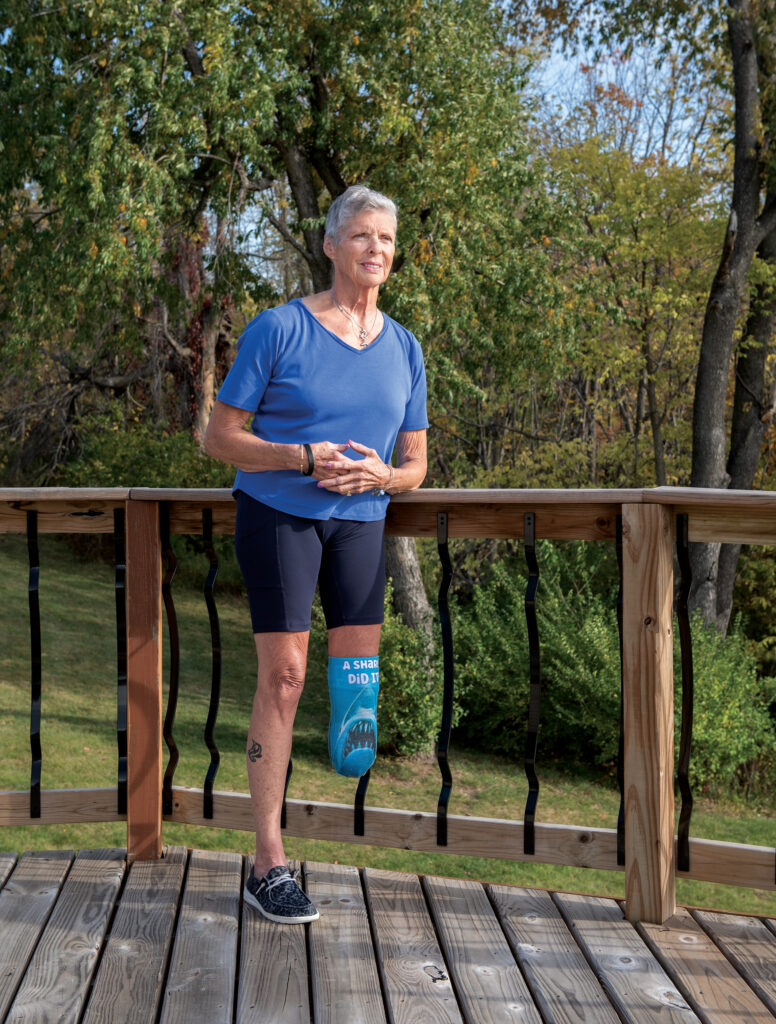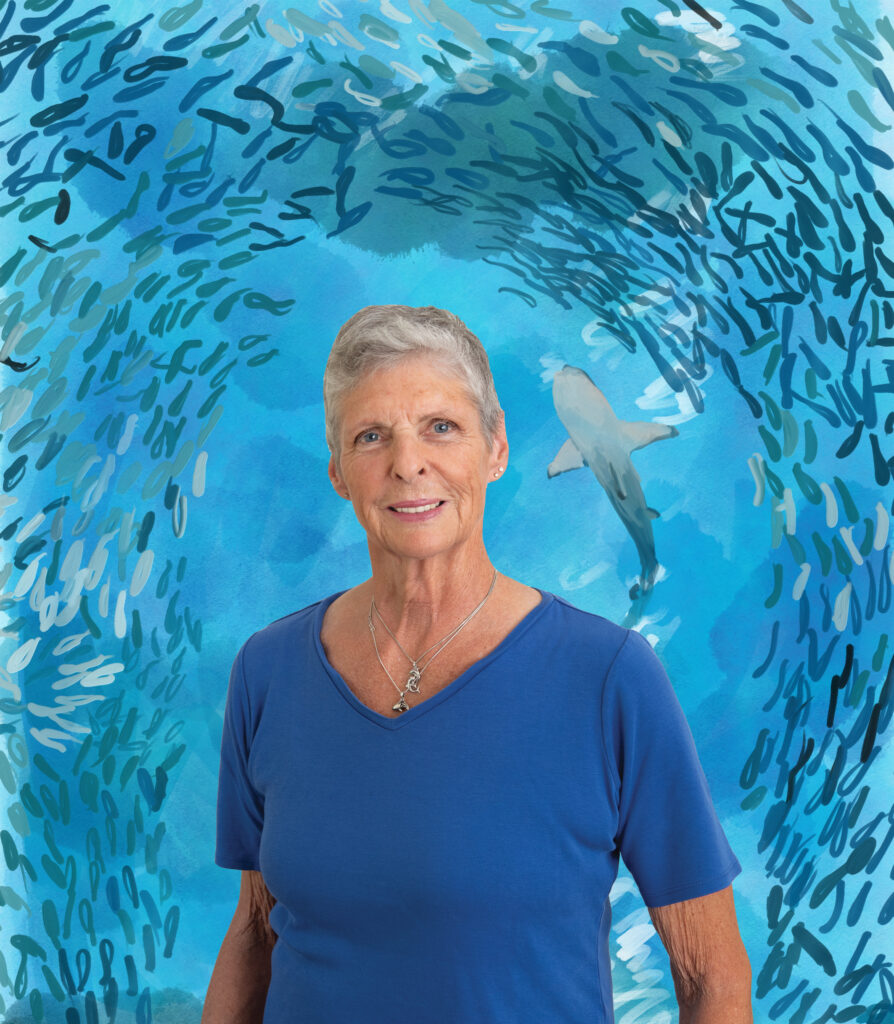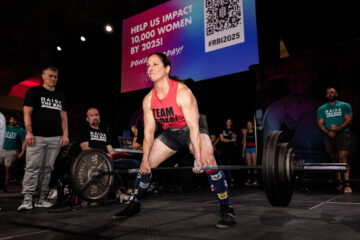
As told to Emily Barske Wood
Heidi Ernst is a 74-year-old physical therapist who has long believed in practicing what she preaches to patients and has done powerlifting, swimming and scuba diving. After her 524th dive on June 7 in the Bahamas, a shark attacked her as she was climbing the boat ladder after completing the dive. She had to have her left leg amputated below the knee at a trauma center in Miami. She lives in Marshalltown. (This interview was conducted in late August in the midst of her recovery.)
The following story has been formatted to be entirely in her words, and has been edited and condensed for clarity.
I’ve always believed as a physical therapist, I need to set a good example for my patients. I’ve always been active. I’ve gone to the Y, lifted weights, swam. I swam competitively in Masters for a long time. I had started doing some powerlifting.
Years ago, I had wanted to get into scuba diving. I was always afraid to do that. Then I thought, you can’t go through life avoiding the things that you fear. The Y offered an “explore scuba diving” type thing. You could go in and you could try on the gear and they would help you put the regulator in your mouth, and then you could swim around in the recreation pool, which is not very deep. I think I was in there the whole entire time that they allowed us to and I was, like, “Wow, this is really cool. I’m going to have to try this.”
So then I signed up for their actual scuba class that they were going to offer, and they canceled that because they didn’t have any participants who signed up other than myself. So then I looked for other scuba instruction classes in Iowa. I found one in Cedar Rapids. And the same thing happened. Not enough participants, so they canceled the class. I thought, well, I’ll be darned, nobody is doing these classes here in Iowa. So I’m going to have to look elsewhere.
I had been going to the Bahamas a time or two a year just to do some healing with dolphins. It is thought that dolphins are able to sense where a person needs healing and they would use their sonar to assist with that. There were actually classes run by the Upledger Institute in Florida to do craniosacral therapy in the water. I signed up for those and got to know some people at this resort, out of which we would go to the different areas to work on each other in the water, and then also we would go to this dolphin sanctuary where we would do some of our coursework.
I got to talking to somebody I got to know at the resort and I was telling him that I wanted to learn how to scuba dive, and he said, “Well, why don’t you go see the folks at Grand Bahama Scuba?” He directed me to them, and I signed up for their class. That was back in 2012. I got certified while I was down there, and then I kept going back three or four times a year. I just kept diving and getting more certifications. I really was hooked right from the get-go.
The first day we go out on the boat – I was so nervous. I’m thinking I’m never gonna be able to do this. I just told myself, “Yes, you are.” The first dive of the day was at a shallow reef, 12 to 13 feet. The reason for doing the shallow reef is that if you had to pop up for air, it wouldn’t be an issue because it was less than 15 feet deep. It was really beautiful. I kept breathing in too much air and I kept floating up, and I had a hard time staying down. But the reef was just gorgeous and we swam around it.
Then the second dive of the day was going to a deeper area. We learned to go down the rope, and stop and clear our ears, and then keep going. I got down and there were several divers ahead of me. It was a really beautiful day and I remember the ocean being really blue. Then, 25 to 30 feet away from me was a barracuda. I kept watching him and I’m thinking, wow, what a beautiful fish, and yet I was somewhat intimidated by the teeth that they always show. I’m like, well, he doesn’t seem to be coming towards me, so I think I’ll be OK. I focused more on going down further. I noticed how the bubbles that the divers below me were giving off as they were exhaling were coming up. I was still in a zone where there was a lot of daylight and sunlight, and as the bubbles were coming up to the surface it just looked like diamonds glistening. I thought, wow, this is just absolutely beautiful. I completely forgot about my fear at that time and I just kept on going further down. My dive instructor was very close by, so she was always making sure I was OK.
There have been dives when I’ve had some fears come up. All of a sudden something would happen in my head and I think I’m gonna start panicking, but I just tell myself I’ll be OK.

I’ve done 524 dives. After the 524th is when the accident happened.
We had been diving in an area where there are commonly sharks. Caribbean reef sharks are naturally curious. They would come up and check us out, and our instructor would take pictures of some of us with the sharks in the background. Then pretty soon the sharks would kind of go on their own, swim away and sometimes they would circle back to check us out and then we would go on to the reef.
We had completed our dive and went up. I think I was the last one up and I got rid of my dive gear and my wetsuit, and I hopped back in the water because I needed to go to the bathroom. So I did that and I was right next to the ladder leading back up to the boat. I was hanging onto the platform and then I just scooted over to the ladder. I had both hands on the top rung and had already taken a step with my right foot on the bottom rung and started to take a step with my left foot when a shark came up from below.
It was unprovoked, meaning I didn’t do anything to attract the shark. I wasn’t feeding it, I wasn’t splashing around. I wasn’t doing any of that. I was merely trying to get back on the boat.
When I saw it with my leg in its mouth I struck it with my left fist and sustained an injury on this middle finger as I hit its teeth. And the story goes, I don’t remember this, but one of the crew members apparently kicked the shark in the head also to make it let go of my leg, and I scrambled up the ladder and got back in the boat. I never lost consciousness. I was fully aware of what was going on the entire time. Needless to say it was a bloodbath in the back of the boat.
The divemaster put the tourniquet on right away. His wife got on the phone and contacted land to get an ambulance ready and the hospital ready. We headed for shore, which was I’m guessing probably a 10-minute ride. I know we were going as fast as the boat could go. I remember feeling the vibration of the engine, which was right below where I was lying on the back on the floor of the boat. The divemaster putting the tourniquet on my leg stopped the bleeding ultimately.
There are two things I thought about. First was, I know I’m going to lose this leg, and I don’t want to die. I begged the divemaster who had the tourniquet on my leg. I said to him, “Please don’t let me die.” He just said, “No, I won’t.”
There was a young man on the boat who cradled my head, and he was very instrumental in keeping me calm. I think we prayed together. He was very encouraging the whole time letting me know that I was going to be all right. He had a strong Christian background, and I think that’s what he used to really comfort me and keep me connected to my prayers. At one point, I felt myself floating off the boat, and I was in a floating position with my arms and legs. Just as if I were floating or tumbling through the air. I had no wounds. There was no blood, there was no pain, and it was completely still and peaceful. All I could see was the blue sky with some beautiful white fluffy clouds, and it was just so beautiful and so welcoming – and then it felt like a bang and I was back on the boat in excruciating pain with blood all over the place.
What was this? I don’t know. Some people claim, well, you just fainted. Well, I don’t think that was fainting because fainting to me was not blissful like that. I could draw a picture of what I experienced if I could paint, so it was more than that. Whatever a person wants to believe, to me, it was that I was very near to death. Then I came back and I have a purpose.
When we got back to shore, the ambulance was ready for me and they lifted me out of the boat, put me in the ambulance and took me to the local hospital. There they completed the stabilization and I had my first surgery. Apparently the shark had broken the fibula in a couple of spots and so the orthopedic surgeon stabilized that. I had a lot of blood loss so they gave me blood and then the area air ambulance was contacted to airlift me to Miami. So the next day we did that. So I was at Jackson Memorial trauma and burn center for about 10 days. That’s where they ended up amputating my leg, not because of the shark bite. A lot of people ask me, “Well, did the shark have a filthy mouth or why did you have infection?” Apparently it has nothing to do with that other than I had an open, gaping wound and having been in saltwater. That’s what created the infection, caused by bacteria called Vibrio vulnificus, essentially it can be a flesh-eating bacteria.
So when I got to the trauma center in Miami, the first doctor that evaluated my leg, he already noticed that there was infection in my foot, so the decision was made to amputate. His recommendation was amputation because he said even if it would heal, and if more infection would not occur, I would probably still have a lot of pain. He could not guarantee that he could reattach the nerves and the blood vessels, so I would still have drop foot and all of the symptoms that I had before. Meanwhile, my foot had completely dropped, and I had no feeling at all. It turned black. The nerves had been severed. Arteries and veins were completely severed. I’ve been asked several times, “Well, weren’t you sad about the limb loss?” I wasn’t crazy about it, but I didn’t really shed any tears over it because I knew it was necessary for that to happen. Without that I would have probably had infection after infection and ultimately, maybe, would have lost my leg further up above the knee or even higher. So I am really grateful that I have a long stump No. 1, and first and foremost, I’m grateful that I’m still alive because it was touch and go.
I knew right away that amputation was going to be what needed to be done. That night they amputated. When I woke up, I knew what to expect. I didn’t have any qualms about seeing my leg shortened or when I saw the stump for the first time when it was unwrapped. I have seen all of that in my medical training. I kind of had an idea of what to expect in terms of how the timeline was gonna go with the healing part: shrinking the stump down to a good volume and then starting with the prosthetist building the prosthesis, learning how to walk again. Those are the steps that I knew were going to happen, so I wasn’t in the dark about it.
I’ve been a physical therapist for 36 years. I worked in a facility where we did a lot of wound care. So wounds did not scare me. Burns did not scare me. I saw a lot of pretty severe injuries. Yeah, it was my own, but I think maybe you can detach from that a little bit, just as I learned to detach from my patients’ wounds and burns, and just look at it from a clinical standpoint. My doctors were just the most amazing people. The care that I got there was just unbelievable and all the expertise bundled in these teams was just fantastic. They all knew that I was a physical therapist and so they also explained things to me at my level of understanding.
The doctor who amputated my leg asked the nurse to have a psychologist come see me. He also said to have someone from hospital administration come to see me. This really smartly dressed, beautiful young woman walked in. I’m thinking, what are we going to talk about? She sat down, and it turned out that she was a below-knee amputee also. She had lost her leg 12 years prior to the date that we were talking and she was telling me about different things that she had since then done. She picked up running marathons. She runs two marathons a year. I thought, wow, that’s amazing.
When we finished talking, I thought, I’m gonna watch her walk out of here. I could not detect anything in her gait pattern that told me that she was an amputee. It was just amazing. I thought, wow, she is an example for me to get back to doing what I would love to do – and what I will be doing. It’s not just about sports activity, but also I live on 40 acres. I have a lot of mowing to do, and one of the pastures I mow with a tractor and I have to have my left leg able to operate the foot pedal. Right now, I can’t do that, but I figured out a way to get on my zero turn mower. I have a horse, my own horse, and then a horse that’s being boarded in my place. I need to do chores, brush them. I need to be able to get in and out of the barn without falling. I need to be able to get out of the horse’s way if they sidestep or if they happen to spook. So currently I’m not able to go in there because I just don’t think it’s safe. Fortunately, I have someone who is doing that.
Right now I’m going through physical therapy and also hand therapy. I’m mainly working on core and strengthening my balance because that’s what I’m going to need as I progress to doing the prosthetic training, which is going to be another step in a different direction. Then I’ll be learning how to walk and develop a gait pattern that’s as normal as possible. I see pictures of people with prostheses and I notice a lot of times they’re not weight bearing equally. They’re hanging out more on the sound leg. With equal weight bearing you’re also going to have less of a limp. This young woman who came into my hospital room, where I could not detect anything, was just the most amazing case of an amputee that I’ve ever seen. That would be the outcome that I think any therapist that’s working with me would desire.
It’s almost an expectation from not only my friends, but also from clinicians that, sooner or later, I’m going to have some emotional issues and might have PTSD from the shark bite. That could be, but at this point, I have not had any nightmares. I have not had any flashbacks. I can talk about this freely. I’ve had people ask me whether I had any pictures of the bite marks on my leg. I don’t have any problem with that. The psychologist that I saw in Miami, she thought that I was still in sort of what they call a survivor mode, and that it would probably hit me later. I’m still waiting for that to happen.

I had one day when I felt a little bit down because I was watching this video of a restaurant in Freeport, Bahamas, where my dive friends and I had just been a few days prior to the accident, where they were doing line dancing. I’ve never been much into line dancing, and my girlfriend went up and started. She goes, “Come on Heidi, let’s get up here and do this.” So I did and I actually had a lot of fun. So this day when I was having a little bit of an emotional thing, I was watching this video, and I’m thinking, well, I still had both legs then. I’m not going to be able to do that. Then I immediately said, “Of course you are because you’re going to have a prosthesis that will allow for you to do that.”
It’s a shame that with all the hype in the media about shark bites, including what happened to me, that people will have these fears about doing something like scuba diving or snorkeling. Sharks are not out to eat people; their diet does not constitute human flesh. Yeah, great whites have eaten people, but primarily their diet consists of fish. Caribbean reef sharks definitely don’t like people. The shark that bit me, who knows what it thought my leg was?
They had been hand-feeding sharks out of a neighboring dive site prior to us going down for our dive with the sharks. When that happens, sharks are being trained to come to the surface and being fed by people. That’s what this shark was doing. He came to the surface and thought maybe my leg was something edible. I don’t want to hurt dive operators or any other tourist operators, but in my view, hand-feeding sharks at the surface should not be allowed because we’re training the sharks to do that.
The people that I dive with have never seen any aggression from these sharks. In the 11 years that I’ve been diving with them we always go back to this shark dive site. Never ever have I seen anything where a shark would bump any of us or show any aggression. So this was really an isolated incident.
There was a post on Facebook about one of the initial interviews I gave with the media. As it goes on Facebook, some commented in my favor and others were highly critical of me even diving. Why would you dive when you’re going to be confronted with sharks? Essentially, it was my own fault because I was diving with sharks. One person mentioned, without even having any idea of how this whole thing happened, well, if you go splashing around in the ocean, it’s a given that you’re going to get bitten by a shark because that’s what attracts them. The things that some people come up with are just amazing. This was totally unprovoked.
I don’t blame the shark. Really there is no blame to go around on any of us in that dive operation. One of the sad parts was that the dive operation was being criticized and had threatening emails and cancellations after the media had brought it to the people’s attention. But again, that’s how some people react to adverse situations. I will continue to advocate for sharks because I’m not afraid of sharks, but I respect them.
——————
A lot of people think that I’m super strong. I don’t view myself as that. I just knew from the beginning that I needed to keep moving forward. Because sitting around and feeling sorry for myself was not going to get me there. What was going to get me there is getting back to the Y, getting into physical therapy, getting my prosthesis, and getting back to diving and doing my powerlifting, jumping on the tractor, doing all the things I was doing before. That’s what my life is about. No, I don’t want to live the last years of my life sitting in a wheelchair or feeling sorry for myself. That’s not going to happen.
God has a purpose for me. I haven’t figured out what it is, but I do have some ideas about what has been going through my mind as I’m navigating being only on one leg and with an assistive device. People with disabilities and handicaps, they’re really not always well served. I’m noticing this where there are no push button entries or no automatic doors. And I’m thinking, I know I’m not the only one who has a problem getting in through doors, especially when you have to pull them open, and they’re very heavy. There’s no way I can do this, and I’m in shape. What about a really elderly person who comes who has no upper body strength, and they’re standing there having to wait for somebody to open the door? Sidewalks are full of cracks and uneven areas. We’re not fixing any of that. Curbs are high in some areas. The handicap accesses are always at the end of the block, so you’re forced to go clear to the end of the block and come around.
Patient advocacy is something that I would like to get into for people with disabilities who need somebody to stand up for issues like this. Maybe that’s my calling. I will deal with some of that with my work, too, because we always want to make sure that our patients and residents have what they need to be able to have as functional a lifestyle as they can. But when it affects you personally, then it’s a little bit different and you go wait a minute, this isn’t right. Something should be done.
What does it mean to be fearless?
My late husband was a firefighter. And I once said to him, “You are totally fearless.” And he goes, “No, I’m not.” I said, “You go into fires and you put them out and you crawl around in houses that are ablaze. How can you not be fearless?” He goes, “I’m not fearless. That is something I have to do, and I have to overcome that when I go into a house that’s ablaze.”
So fearless is using your expertise in whatever you’re wanting to do, whether it’s scuba diving or jumping out of an airplane or running into burning buildings, to the point where you know what to do under those really extreme circumstances. To me, that’s being fearless – not that you’re not afraid.



2 Comments
Cindy Hewitt · October 30, 2023 at 1:18 pm
Heidi, your ability to persevere and make the most of your life rather than focus on what you lost is inspirational. It is the only way to have a fulfilling and happy life, yet is so difficult for many. Looking forward to following your ongoing progress.
Dennis stalzer · November 2, 2023 at 10:50 am
Amazing, I’m sure you’ll be diving again and posting more beautiful pictures.
Comments are closed.